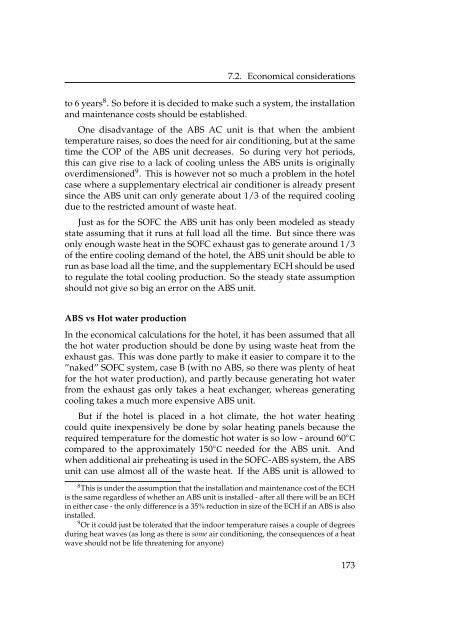integration of solid oxide fuel cells and ... - Ea Energianalyse
integration of solid oxide fuel cells and ... - Ea Energianalyse
integration of solid oxide fuel cells and ... - Ea Energianalyse
Create successful ePaper yourself
Turn your PDF publications into a flip-book with our unique Google optimized e-Paper software.
7.2. Economical considerations<br />
to 6 years 8 . So before it is decided to make such a system, the installation<br />
<strong>and</strong> maintenance costs should be established.<br />
One disadvantage <strong>of</strong> the ABS AC unit is that when the ambient<br />
temperature raises, so does the need for air conditioning, but at the same<br />
time the COP <strong>of</strong> the ABS unit decreases. So during very hot periods,<br />
this can give rise to a lack <strong>of</strong> cooling unless the ABS units is originally<br />
overdimensioned 9 . This is however not so much a problem in the hotel<br />
case where a supplementary electrical air conditioner is already present<br />
since the ABS unit can only generate about 1/3 <strong>of</strong> the required cooling<br />
due to the restricted amount <strong>of</strong> waste heat.<br />
Just as for the SOFC the ABS unit has only been modeled as steady<br />
state assuming that it runs at full load all the time. But since there was<br />
only enough waste heat in the SOFC exhaust gas to generate around 1/3<br />
<strong>of</strong> the entire cooling dem<strong>and</strong> <strong>of</strong> the hotel, the ABS unit should be able to<br />
run as base load all the time, <strong>and</strong> the supplementary ECH should be used<br />
to regulate the total cooling production. So the steady state assumption<br />
should not give so big an error on the ABS unit.<br />
ABS vs Hot water production<br />
In the economical calculations for the hotel, it has been assumed that all<br />
the hot water production should be done by using waste heat from the<br />
exhaust gas. This was done partly to make it easier to compare it to the<br />
”naked” SOFC system, case B (with no ABS, so there was plenty <strong>of</strong> heat<br />
for the hot water production), <strong>and</strong> partly because generating hot water<br />
from the exhaust gas only takes a heat exchanger, whereas generating<br />
cooling takes a much more expensive ABS unit.<br />
But if the hotel is placed in a hot climate, the hot water heating<br />
could quite inexpensively be done by solar heating panels because the<br />
required temperature for the domestic hot water is so low - around 60 ◦ C<br />
compared to the approximately 150 ◦ C needed for the ABS unit. And<br />
when additional air preheating is used in the SOFC-ABS system, the ABS<br />
unit can use almost all <strong>of</strong> the waste heat. If the ABS unit is allowed to<br />
8 This is under the assumption that the installation <strong>and</strong> maintenance cost <strong>of</strong> the ECH<br />
is the same regardless <strong>of</strong> whether an ABS unit is installed - after all there will be an ECH<br />
in either case - the only difference is a 35% reduction in size <strong>of</strong> the ECH if an ABS is also<br />
installed.<br />
9 Or it could just be tolerated that the indoor temperature raises a couple <strong>of</strong> degrees<br />
during heat waves (as long as there is some air conditioning, the consequences <strong>of</strong> a heat<br />
wave should not be life threatening for anyone)<br />
173
















